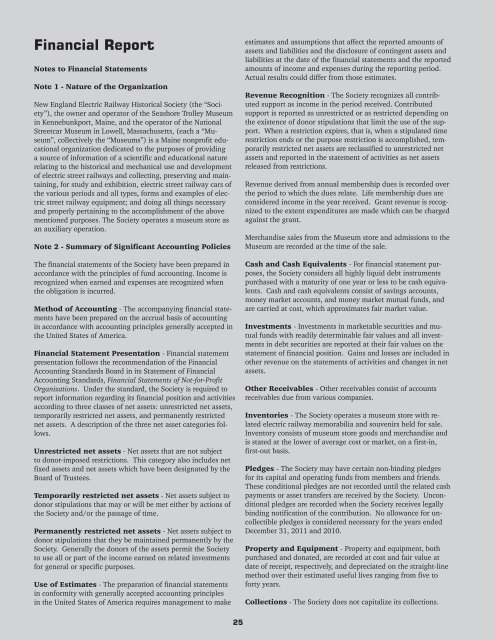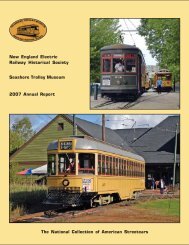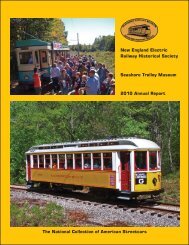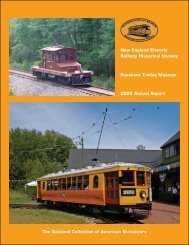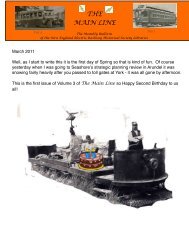2011 Annual Report - the Seashore Trolley Museum
2011 Annual Report - the Seashore Trolley Museum
2011 Annual Report - the Seashore Trolley Museum
Create successful ePaper yourself
Turn your PDF publications into a flip-book with our unique Google optimized e-Paper software.
Financial <strong>Report</strong><br />
Notes to Financial Statements<br />
Note 1 - Nature of <strong>the</strong> Organization<br />
New England Electric Railway Historical Society (<strong>the</strong> “Society”),<br />
<strong>the</strong> owner and operator of <strong>the</strong> <strong>Seashore</strong> <strong>Trolley</strong> <strong>Museum</strong><br />
in Kennebunkport, Maine, and <strong>the</strong> operator of <strong>the</strong> National<br />
Streetcar <strong>Museum</strong> in Lowell, Massachusetts, (each a “<strong>Museum</strong>”,<br />
collectively <strong>the</strong> “<strong>Museum</strong>s”) is a Maine nonprofit educational<br />
organization dedicated to <strong>the</strong> purposes of providing<br />
a source of information of a scientific and educational nature<br />
relating to <strong>the</strong> historical and mechanical use and development<br />
of electric street railways and collecting, preserving and maintaining,<br />
for study and exhibition, electric street railway cars of<br />
<strong>the</strong> various periods and all types, forms and examples of electric<br />
street railway equipment; and doing all things necessary<br />
and properly pertaining to <strong>the</strong> accomplishment of <strong>the</strong> above<br />
mentioned purposes. The Society operates a museum store as<br />
an auxiliary operation.<br />
Note 2 - Summary of Significant Accounting Policies<br />
The financial statements of <strong>the</strong> Society have been prepared in<br />
accordance with <strong>the</strong> principles of fund accounting. Income is<br />
recognized when earned and expenses are recognized when<br />
<strong>the</strong> obligation is incurred.<br />
Method of Accounting - The accompanying financial statements<br />
have been prepared on <strong>the</strong> accrual basis of accounting<br />
in accordance with accounting principles generally accepted in<br />
<strong>the</strong> United States of America.<br />
Financial Statement Presentation - Financial statement<br />
presentation follows <strong>the</strong> recommendation of <strong>the</strong> Financial<br />
Accounting Standards Board in its Statement of Financial<br />
Accounting Standards, Financial Statements of Not-for-Profit<br />
Organizations. Under <strong>the</strong> standard, <strong>the</strong> Society is required to<br />
report information regarding its financial position and activities<br />
according to three classes of net assets: unrestricted net assets,<br />
temporarily restricted net assets, and permanently restricted<br />
net assets. A description of <strong>the</strong> three net asset categories follows.<br />
Unrestricted net assets - Net assets that are not subject<br />
to donor-imposed restrictions. This category also includes net<br />
fixed assets and net assets which have been designated by <strong>the</strong><br />
Board of Trustees.<br />
Temporarily restricted net assets - Net assets subject to<br />
donor stipulations that may or will be met ei<strong>the</strong>r by actions of<br />
<strong>the</strong> Society and/or <strong>the</strong> passage of time.<br />
Permanently restricted net assets - Net assets subject to<br />
donor stipulations that <strong>the</strong>y be maintained permanently by <strong>the</strong><br />
Society. Generally <strong>the</strong> donors of <strong>the</strong> assets permit <strong>the</strong> Society<br />
to use all or part of <strong>the</strong> income earned on related investments<br />
for general or specific purposes.<br />
Use of Estimates - The preparation of financial statements<br />
in conformity with generally accepted accounting principles<br />
in <strong>the</strong> United States of America requires management to make<br />
<strong>2011</strong> <strong>Annual</strong> <strong>Report</strong><br />
estimates and assumptions that affect <strong>the</strong> reported amounts of<br />
assets and liabilities and <strong>the</strong> disclosure of contingent assets and<br />
liabilities at <strong>the</strong> date of <strong>the</strong> financial statements and <strong>the</strong> reported<br />
amounts of income and expenses during <strong>the</strong> reporting period.<br />
Actual results could differ from those estimates.<br />
Revenue Recognition - The Society recognizes all contributed<br />
support as income in <strong>the</strong> period received. Contributed<br />
support is reported as unrestricted or as restricted depending on<br />
<strong>the</strong> existence of donor stipulations that limit <strong>the</strong> use of <strong>the</strong> support.<br />
When a restriction expires, that is, when a stipulated time<br />
restriction ends or <strong>the</strong> purpose restriction is accomplished, temporarily<br />
restricted net assets are reclassified to unrestricted net<br />
assets and reported in <strong>the</strong> statement of activities as net assets<br />
released from restrictions.<br />
Revenue derived from annual membership dues is recorded over<br />
<strong>the</strong> period to which <strong>the</strong> dues relate. Life membership dues are<br />
considered income in <strong>the</strong> year received. Grant revenue is recognized<br />
to <strong>the</strong> extent expenditures are made which can be charged<br />
against <strong>the</strong> grant.<br />
Merchandise sales from <strong>the</strong> <strong>Museum</strong> store and admissions to <strong>the</strong><br />
<strong>Museum</strong> are recorded at <strong>the</strong> time of <strong>the</strong> sale.<br />
Cash and Cash Equivalents - For financial statement purposes,<br />
<strong>the</strong> Society considers all highly liquid debt instruments<br />
purchased with a maturity of one year or less to be cash equivalents.<br />
Cash and cash equivalents consist of savings accounts,<br />
money market accounts, and money market mutual funds, and<br />
are carried at cost, which approximates fair market value.<br />
Investments - Investments in marketable securities and mutual<br />
funds with readily determinable fair values and all investments<br />
in debt securities are reported at <strong>the</strong>ir fair values on <strong>the</strong><br />
statement of financial position. Gains and losses are included in<br />
o<strong>the</strong>r revenue on <strong>the</strong> statements of activities and changes in net<br />
assets.<br />
O<strong>the</strong>r Receivables - O<strong>the</strong>r receivables consist of accounts<br />
receivables due from various companies.<br />
Inventories - The Society operates a museum store with related<br />
electric railway memorabilia and souvenirs held for sale.<br />
Inventory consists of museum store goods and merchandise and<br />
is stated at <strong>the</strong> lower of average cost or market, on a first-in,<br />
first-out basis.<br />
Pledges - The Society may have certain non-binding pledges<br />
for its capital and operating funds from members and friends.<br />
These conditional pledges are not recorded until <strong>the</strong> related cash<br />
payments or asset transfers are received by <strong>the</strong> Society. Unconditional<br />
pledges are recorded when <strong>the</strong> Society receives legally<br />
binding notification of <strong>the</strong> contribution. No allowance for uncollectible<br />
pledges is considered necessary for <strong>the</strong> years ended<br />
December 31, <strong>2011</strong> and 2010.<br />
Property and Equipment - Property and equipment, both<br />
purchased and donated, are recorded at cost and fair value at<br />
date of receipt, respectively, and depreciated on <strong>the</strong> straight-line<br />
method over <strong>the</strong>ir estimated useful lives ranging from five to<br />
forty years.<br />
Collections - The Society does not capitalize its collections.<br />
25


